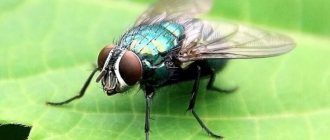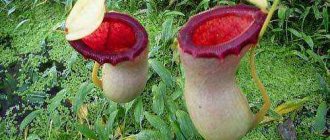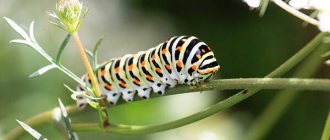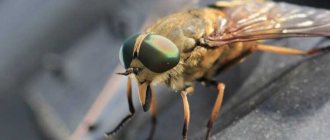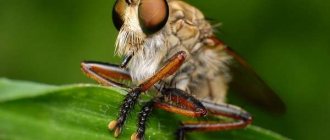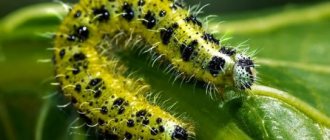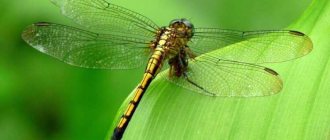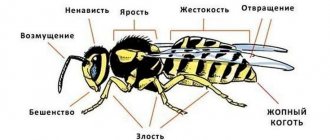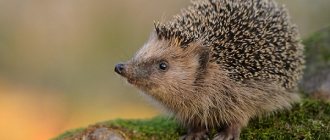Dragonflies are the oldest insect predators: the remains of their distant ancestors discovered by archaeologists date back to the Carboniferous period (350-300 million years ago). However, many years of evolution have had virtually no effect on the appearance of dragonflies, so these creatures are classified as primitive. To date, scientists have discovered and classified more than 5,000 species of these insects. But the species of dragonflies that can be observed in the European part of Russia are very few in number: there are no more than a hundred of them. These insects prefer tropical climates, so the vast majority of them inhabit the humid forests of South America and Southeast Asia. Dragonflies are not found in regions with arid climates.
Born predator
Without exception, all types of dragonflies (both nymphs and adults) feed on insects, often blood-sucking (horseflies, mosquitoes, midges). The dragonfly's body shape is ideal for hunting on the fly. These insects are “lean”, with a pronounced chest and elongated abdomen. The head of a dragonfly is very mobile. There are two complex compound eyes on it, allowing the insect to see everything that happens around and behind, and between these two there are ordinary ones, which serve for orientation in space. The organs of vision are designed in such a way that a dragonfly sees best against the sky. Therefore, she attacks the victim from below. The insect has a powerful mouth (“gnawing,” as scientists say), short antennae and stiff legs covered with hairs that help capture prey. Each representative of the order has two pairs of wings, which are equally well developed. This means that it is a bimotor insect. Dragonflies can fly at speeds of over 55 km/h.
The name is the basis of the character and semantic meaning of the dragonfly
English DRAGONFLY
Contains 2 words:
DRAGON - “dragon”;
FLY - has two meanings:
- verb: “fly”;
- noun: “fly, front sight.”
That is, the English name enshrines the formal, figurative meaning of a dragonfly, as an external resemblance to a dragon. She is a kind of dragon fly, a dragon fly.
Indeed, if a dragon is a snake with wings, then a dragonfly is a winged worm.
Latin ODONATUM
Some sources translate this as “born from the fragrance of the Universe,” that is, produced by subtle, spiritual vibrations.
And in another interpretation it is just “equipped with teeth” (dental growths).
And since the Latin language operates precisely on the dense plane, it seems to me that it is precisely this semantics that is meaning-determining here.
Russian DRAGONFLY
In the emergence and retention of this name among the Slavs, homonym verbs “strekat” could have been involved in two meanings:
- “to sting” - although dragonflies are predators, and in some traditions they were also considered poisonous, they do not have a stinging effect (like bees, wasps, snakes). So it is unlikely that our ancestors wanted to put this meaning into the name;
- “jump” - after all, the movements of this insect really look like a series of unexpected jumps and sudden stops.
There is also an opinion that the Slavic name could be based on the verb “chirp”, that is, the word captures precisely the subtle chirping sound that a dragonfly makes when flying.
If “a fly is a clattering sound,” then a dragonfly is a clattering sound :)
The spiritual meaning of the dragonfly totem and the meaning of its abstract symbolism for a person can best be considered based on its names and qualities of this creature in reality.
Homoptera
There are three suborders of dragonflies. The first of them is Homoptera. It includes graceful, light and, as a rule, small insects with a very elongated abdomen. Both pairs of wings are identical in size and shape; when at rest, the dragonfly folds them at the back so that they form an acute angle with the surface of the back. Homoptera fly slowly and smoothly. Among them are such species of dragonflies as the graceful arrow, the beauty-girl and the dim lute. Homoptera nymphs living in water have a special respiratory organ located at the end of the abdomen - caudal gills.
Population and species status
Photo: What a dragonfly looks like
The population of the order Odonata is large and diverse. There are more than 6,650 species of these insects in the world. These insects are found on all continents and migrate. Many species of these insects live and reproduce well in the wild. However, today some species of dragonflies are on the verge of extinction and their populations are rapidly declining. This is due to human pollution of dragonfly habitats.
A number of species are listed in the Red Book. At the end of 2022, there are more than 300 species listed in the Red Book. Of these, 121 species are on the verge of extinction, 127 subspecies have the status of insects in a vulnerable position, and 19 subspecies are already extinct. The species Megalagrion jugorum is considered extinct. In the global population, about 10% of all dragonfly species are on the verge of extinction.
Dragonflies are a very important group that indicates the condition of water bodies, since dragonfly larvae react strongly to any changes in water quality. Dragonfly larvae die in polluted waters. In order to maintain the population of these insects, it is necessary to be more careful about the environment. Install cleaning equipment at enterprises, create protected areas in dragonfly habitats.
Variopterans and Anisozygoptera
The second suborder is heteroptera. They have a powerful body, and the base of the hind wings is widened. The eyes often touch. The flight speed of heteroptera is high. At rest, the wings of these dragonflies are spread apart. The larvae of dragonflies live in mud and breathe using rectal gills. It is worth mentioning some species of dragonflies belonging to heteroptera. This is an ordinary grandfather, a large rocker, a bronze headstock, and a blood dragonfly.
Representatives of the third suborder (Anisozygoptera) combine the characteristics of the first two, although in appearance they are closer to heteroptera. These dragonflies do not live in Russia.
Description of appearance
The black dragonfly or compressed belly dragonfly (Sympetrum danae) is one of the small representatives of its family. It belongs to the genus Sympetrum. It is characterized by species-specific coloring features that make it possible to recognize the insect from a distance. The body length of the black dragonfly is slightly more than 30 mm, the size of the hind wing is 22-28 mm. The structure of the insect is characteristic of the true dragonfly family. The large head is movably connected to the chest. The body is elongated, the abdomen is elongated, its length is 18-26 mm. Males and females differ in color. Black color is a distinctive feature of adult sexually mature males. Young males have yellow spots on their bodies that gradually disappear.
The black eyes, which occupy most of the head, touch in a small area. This organ structure is characteristic of heteroptera dragonflies. Compounded eyes are made up of thousands of individual ocelli that perceive the world around them. The antennae are inconspicuous and consist of 4-7 segments. Powerful paired jaws make it easy to tear prey into pieces.
The body and head of the female are yellow-brown in color; there are two longitudinal black stripes on the sides of the abdomen. The chest and head are covered with hairs. On the posterior edge of the prothorax there is a vertical projection with a fringe of dark hairs. The chest is covered with a black and yellow pattern on the underside and sides. The transparent wings are long and narrow, with abundant veining. On the leading edge of each wing there is a dark spot - the wing ocellus. This thickening helps maintain balance.
Interesting fact. The abdomen occupies up to 90% of the dragonfly's body length.
The elongated abdomen consists of 11 segments formed by two chitinous scutes. Between them there are membranes that allow the insect to bend. The abdomen of females ends with the genital organs, and males have special appendages to hold the partner during fertilization. The black dragonfly has three pairs of limbs. The long legs are black but may have yellow spots. Limbs are not designed for walking or running. The front pair serves to catch and hold prey. Strong claws and several rows of sharp spines help in hunting. The function of the remaining limbs is to ensure the take-off and landing of the insect.
Larva - offspring that are different from their parents
The larvae emerge from the eggs very small. Their body is much shorter than that of the imago. The head is large, the eyes are large, faceted. The oral apparatus consists of paired jaws, an unpaired upper lip and a lower lip, transformed into a grasping organ - a mask. Nymphs of the genus Sympetrum have a helmet-shaped mask. Young offspring prefer to stay near the bottom and often burrow into the mud.
Outwardly, they do not look like adult dragonflies, but the hunter's instinct makes them lie in wait for prey. They hide among aquatic plants and attack invertebrates, mosquito larvae and other insects. Nymphs have long legs; in the early stages of development, they are regenerated after loss. For breathing, larvae of dragonflies use tracheal gills.
Information. Nymphs of black dragonflies are a type of short-bellied crawling larvae.
Beauties
In general, the order of dragonflies stands out among other orders of insects for its aesthetic merits. And it’s basically impossible not to admire the representatives of the family of beauties. For example, beautiful girls are small (up to 5 cm long), thin even-winged dragonflies with a wingspan of no more than 7 cm. The body and wings of males are colored in blue, green, purple shades and have a metallic sheen.
In females, the body is colored, but the wings are not. Beauties prefer the overgrown banks of quiet rivers and small streams. They lay eggs in the leaves of coastal plants; The larvae also try to stay close to the stems and roots. The flight of a beautiful girl resembles the flight of a butterfly.
Predation and unreliability
In our world, everything has a downside, so in the bright image of a cute dragonfly there is also a negative aspect attributed to it.
As a continuation of the qualities of external lightness and detachment, the negative extreme of the abstract meaning of the dragonfly is irresponsibility and unreliability .
Dragonfly by jeweler Rene Lalique (1880). The famous jeweler created this piece of jewelry in the form of a dragonfly (with the appearance of Sarah Bernhardt) being devoured by a lizard. Of course, the actress wanted this brooch and got it. When they asked her what monster’s mouth the dragonfly was in, she answered: “This is the passion that devours me...”
of selfishness and consumerism, cannot but appear .
The image of a dragonfly balances on this edge - as the personification of a femme fatale during the heyday of decadence. She is a lightweight, capricious creature, incredibly beautiful and fickle in her affections, mysterious and feminine, using admirers and abandoning them mercilessly.
For all the enchanted and disappointed men, I.A. Krylov dealt with such a “fatal dragonfly” in his moralizing fable “The Dragonfly and the Ant.”
There, instead of the joy of “what a blessing that you visited us, mademoiselle,” the naive consumer received an instructive ant mockery:
“You sang everything, that’s the point. So go ahead and dance.”
Probably an ant - this earthly worker spent the whole summer preparing for such a situation, composing a text and rehearsing his line. In the end, it turned out powerful, like “ checkmate to you, parasite!!!” "
It is worth noting that, unlike previous generations, modern children do not always unconditionally accept Krylov’s morality; on the contrary, they radically rethink it. For example:
A boy wrote this. And here’s what the wonderful girl said:
Medieval Europe, which imagined witches everywhere and was in a hurry to identify them in any creature, did not allow the dragonfly to become holy. It is logical that a witch's charm and harmfulness were attributed to her; she was even one of the symbols of witches.
“ Devil's needle ” (no more and no less!) They called it here; the prick of this needle was considered poisonous.
You can have fun by suggesting that one of the “witch hunters” decided to depart to another world precisely at the moment when the dragonfly landed on him.
Or that from the distant future, descendants, in their experiments to correct history, sent into the past not a terminator, but a poisonous nanorobot in the form of a dragonfly. And she gave a lethal injection to one of the workers of the Inquisition - the exterminators of beautiful women?
The fantasies can be continued...
Arrows
Arrows are not as spectacular as beauties, but just as graceful dragonflies. The photo of the graceful arrow, posted below, confirms this fact.
Shooters lead the same lifestyle as beauties, except that they choose more modest prey. And it is not surprising, because the body length of the graceful arrow is only 3.5 cm, while the wingspan is 4.5 cm. The male has an elongated blue chest with a longitudinal black stripe and a black abdomen, as if intercepted by thin blue rings. The wings are narrow and transparent. Some females have a similar coloration, others are rather inexpressively colored and have neither stripes nor rings. Arrows fly slowly and rarely leave their homes. Their larvae live and hunt in the stems and roots of aquatic plants. Distinguishing one species from another within this family is not an easy task. But it is impossible to confuse them with another family of arrows.
Lifestyle and habitat
Dragonflies spread successfully only to those areas of the planet where stable negative temperatures are not observed for more than three months a year. Their widespread distribution and species diversity is largely explained by the ancient origin of these insects, their ability to move quickly and actively in space, as well as a variety of food sources and taste preferences.
The lifestyle of such insects is inherently amphibiotic. This means that the eggs and larvae of such living organisms go through the stages of their development in water, while adult individuals (imago) carry out their life activities in the air and on land.
These are excellent flyers, which is easy to see by watching dragonflies in the summer . They are agile and fast and are kind of champions among insects, developing significant speeds through the air, which in some cases can reach up to 57 km/h.
It should be noted not only the speed, but also the art of flight, as well as the maneuverability of these creatures, in which their streamlined bodily forms greatly help them.
The air element can truly be considered a home for the dragonfly. On the fly, she is able not only to dine, but even to mate. Moreover, these are very aggressive, cruel predators, and therefore many living organisms from the insect world have cause for concern if they see the shadow of a dragonfly .
Dragonflies fly beautifully and cover long distances at a speed of 130 km/h with a tailwind
These creatures, having occupied a certain territory, jealously guard it from competitors and fiercely fight for it with their own relatives.
Real dragonflies
This family of the heteroptera suborder includes numerous species of dragonflies. Their names speak for themselves: swamp, flat, blood. These insects are distinguished by a massive, wide and relatively short body, wings slightly shifted towards the head and the presence of dark spots at their base. The female true dragonfly lays eggs directly into the water of a pond or quiet river, and sometimes into coastal sand. Large nymphs of true dragonflies live in the mud. The flat dragonfly is a medium-sized insect. The wingspan is 8 cm, the body length is 4.5 cm. Both females and males have a brownish-yellowish chest, but the male's abdomen is covered with bright blue pollen, while the female's abdomen is brown, with dark stripes on the sides. At the base of both pairs of wings there are dark triangles. The eyes are greenish.
Other representatives of the family are very noteworthy - blood dragonflies (photo below). They are easily recognized by their bright body color - reddish-yellow, orange or brown-red.
These dragonflies are one of the latest. They are active from mid-summer until November. The transformation of blood dragonfly larvae into adults occurs in just a couple of months.
Description and features
Dragonflies are the most ancient and interesting creatures, whose distant ancestors, very similar to modern specimens in structure and appearance, lived on the planet more than three hundred million years ago, that is, during the Carboniferous period.
Since then, their descendants have undergone few progressive changes, and therefore are classified by modern scientists as primitive. But, despite this, these living creatures can rightfully be called unique.
This is manifested in everything: in the structure, in the way of feeding and hunting, in the peculiarities of life, in the tirelessness and speed of these creatures, as well as in their hidden capabilities, with which they still never cease to amaze researchers of the animal world of our grandiose planet.
Dragonfly is an insect belonging to the type of amphibionts, that is, living organisms that have successfully adapted to life in two environments: on land and in water, and therefore they are not found in countries with arid climates.
It is believed that dragonflies appeared before dinosaurs
Many varieties of dragonflies (and there are more than six thousand species in total) carry out their life activities in the tropical regions of Asia and South America, where they are especially widespread in humid forests.
In addition, they live on continents such as Australia and Africa, and are found in Turkey, Iran, Italy and other countries of the Eurasian continent with similar climates.
About a hundred varieties of these organisms have taken root well and exist in Russian spaces. In fact, they have adapted to life on all continents except Antarctica. They are also not found in Greenland and Iceland. You can admire this creature and see its unique perfection in the photo of a dragonfly .
Dragonflies flap their wings about 30 times per minute, so no buzzing sound is heard from them
Characteristic features of their appearance include:
- a relatively large head, movably attached to the chest;
- chest, built from three components (front, intermediate, back);
- a thin long body of a streamlined shape, divided into 11 segments;
- chitinous transparent wings (two pairs);
- bright shiny elongated abdomen;
- hard hairy paws (six pieces).
The coloring of these insects can be the most colorful and original: stand out in blue, green, blue, yellow shades, shimmer with mother-of-pearl, have darkening and spots. In nature you can also find a white (transparent) dragonfly .
The structure of the visual organs of this insect is noteworthy. First of all, these include huge size, occupying three quarters of the head, compound eyes. They are built from thirty thousand elements (facets), each of which can be considered as a separate organ, functioning independently of the others.
The facets are placed in rows, some of which distinguish the volume and shape of objects, and the other part of them perceives color waves of a very different spectrum, including ultraviolet.
The crown of these creatures is equipped with three more simple additional eyes, arranged in a triangle. All organs of vision together allow the dragonfly to view the surrounding space in a circle at all 360° and distinguish the objects it needs at a distance of eight meters or more.
But with all this, the other sensory organs of dragonflies are not sufficiently developed. Their sense of smell is limited. There is no hearing at all, only the antennae located at the base of the wings pick up some sound vibrations.
The unique structure of the eyes allows the dragonfly to view space at 360 degrees
Grandfathers
Among the features of these dragonflies are the variegated coloration, widely spaced eyes and the presence of a notch at the base of the hind wings in males. Grandfathers are capable of long flights and prefer flowing reservoirs with clean water, where females lay eggs directly in flight.
Common dedka, tailed dedka and horned dedka are the most common species of dragonflies in Central Russia. These names sound funny (as well as “metal grandmother” or “bronze grandmother”), but you need to keep in mind that grandfathers are also called rivermen, and grandmothers – patrolmen. The Common Dedka is a black and yellow dragonfly with transparent wings. The coloring is vaguely reminiscent of wasp.
Dedok larvae are voracious, strong and can burrow into soft mud. And adult grandfathers, oddly enough, are short-lived. They live no longer than a month.
Stages of reproduction
When the mating season begins, males become more active, forming clusters near water areas. As soon as the female is fertilized, she flies to the pond. She lays her eggs in the water, leaving them on vegetation in the underwater or terrestrial part. The number of insect eggs can reach up to 600 pieces.
The insect develops in an incomplete cycle. Growth into an adult occurs without a period of pupation. The egg stage period takes from 2 weeks to 1 month, and then the naiad larva is born from it. It also develops in the underwater part.
Since it has gills in the posterior intestinal part, it is able to breathe under water. To supply the body with air, the larva absorbs water through the anus. After processing, the finished liquid splashes out with pressure, thus achieving movement.
During the growth stage, the larvae develop wings. During the initial flight of dragonflies into the air, they are still weak.
The final change of the skin layer occurs on a dry surface. After an hour, the dragonfly can already make its first flight. Experts note that the larval stage can take about 3 years.
Rocker arms
These are large, bright and expressively colored dragonflies. Representatives of the order of dragonflies rarely have such endurance: rockers can fly many kilometers from their native body of water (it happened that they were seen over the ocean). The size of these insects also inspires respect: the wingspan of the watchman-overlord (or emperor) reaches 8 cm.
The patrolmen's chest is greenish, their abdomen is blue, with a yellow ring. The wings of males are completely colorless, while those of females are barely yellowish. The organs of vision are bluish-green. Watchmen live near stagnant, often drying up bodies of water. They lay their eggs in rotting plant tissues immersed in water. Their large larvae are able to cope even with fish fry.
In addition to those mentioned above, in the European part of Russia there are representatives of such families as: grandmothers, lyutki, cordulegasteridae. All dragonflies are considered beneficial. They eat blood-sucking insects and pests and, in turn, are food for birds and fish.
Lifestyle
The black dragonfly leads a typical lifestyle for its family - it is active during the day and spends the night on plants. In the morning hours, winged insects love to bask in the rays of the sun. Males prefer to sit on open ground or rocks. They wait out stormy days with rain and wind in shelters. Like most predators, they lead a solitary lifestyle. Dragonflies spend a lot of time in the air. During flight, their wings are able to move independently of each other, this gives them freedom to maneuver.
Multi-winged dragonflies, if necessary, reach speeds of up to 60 km/h. On normal days, they make more measured flights at a speed of 15-20 km/h. Males do not show territorial aggressiveness. They wait for partners near bodies of water where mating and egg laying take place. The rest of the time the black compressed belly spends searching for prey. They have no food specialization; dragonflies feed on all types of insects they can catch. They hunt in the middle tier, choosing lying in wait tactics.
The lifespan of an imago is 2-3 months. The summer begins in mid-July and ends in October. It reaches its peak in September.
Black dragonflies are shy creatures. It is difficult to get close to them for observation. At the slightest noise they take off and fly away. This behavior is explained by the huge number of dangers that await insects. Their small body size makes them vulnerable. Compressed bellies can become prey for birds, reptiles, mammals and relatives of larger species. But with caution and patience, you can wait until the small, fragile black dragonfly lands on your palm.
Spreading
The habitat of the black dragonfly is the entire Palearctic. This species is observed in northern and central Europe, Asia, the Far East and the Caucasus, and North America. The insect lives in most of Russia, except for the southern regions. Dragonflies choose stagnant bodies of water on acidified soils. They often settle near drainage ditches, in lowlands and swamps. Representatives of the genus Sympetrum are characterized by migration.
Lifecycle Properties
And finally, the deepest meaning of the dragonfly totem, again reminiscent in its meaning of a butterfly, because both of them are a symbol of life changes, transformation .
This is based on the fact that there are two stages of the biological cycle of dragonflies, water and air:
The first is when birth occurs in water and existence in the form of a larva. Water represents depth of emotion or inner layers of information.
The second is when the already winged insect enters the element of air and receives the joy of using feelings and information in the outside world. Symbolically, this is her chirping - verbalization, contacts, connections, realization through the exchange of internal and external.
As a combination of two elements, this insect personifies the connection between the unmanifested and manifested worlds . For example, there is a very interesting film “Dragonfly” (with Kevin Korstner in the title role), where the deceased wife of the main character sends him a message with the help of her dragonfly totem and leads him to the goal they both need...
Also connecting the elements of water and air, the dragonfly can become a symbol of metamorphosis , the disclosure of the hitherto hidden internal potential in a person to the outside world.
Let us remember that the Indians of North America (and after them the current inhabitants of these territories) consider dragonflies to be a symbol of rebirth and gaining greater strength after difficult, complex trials.
“In thunderstorms, in storms, in the coldness of life, during heavy losses, and when you are sad, appearing smiling and simple is the highest art in the world.” (S. Yesenin, poem “Black Man”)
Dragonfly qualities in human performance are internal strength with external fragility and sensitivity , the ability to combine subtlety of feelings and developed intelligence , doing it easily and naturally.
In principle, one can perceive and use the dragonfly as a symbol of poetry (Neptune + Mercury), the process of creation of which flows from the depth of feelings - into verbal lightness.
Dragonfly - can be perceived as a symbol of the transience of life. Among the Japanese who love it, the red dragonfly is the herald of the coming autumn. Its ancient name is “Akitsu” (akitsu-mushi) - autumn insect:
“Autumn is coming - the Red Dragonfly has flown to us with the news.” (Sirao. Per. A. Valley)
For spiritual seekers and practitioners, another transformational meaning of the totem is that it encourages the search for one’s own illusions and self-deception, and through liberation from them, the acquisition of greater opportunities.
The dragonfly is a symbol that calls for “flying” in all dimensions of the world (3+), easily playing with its levels – physical, social and spiritual, redirecting the focus of attention in a timely manner without losing the feeling of lightness and positivity – which only a developed person is capable of.
This is close to the state of “Here and Now” , where Eternity flows and from where Infinity unfolds...
Tags: Totems of birds and animals
- Related Posts
- Bear - symbol and totem
- Animal – brand, logo and mascot
- The hare is a symbol and totem

